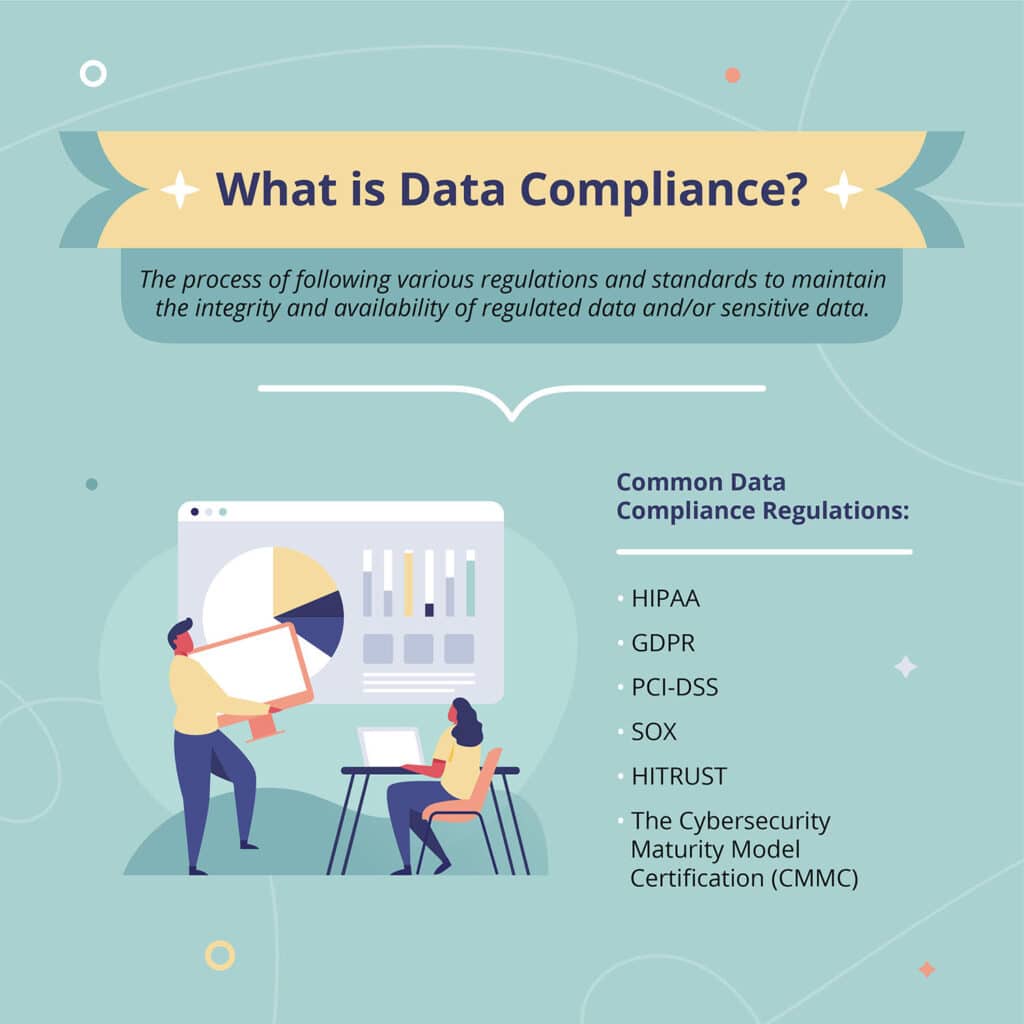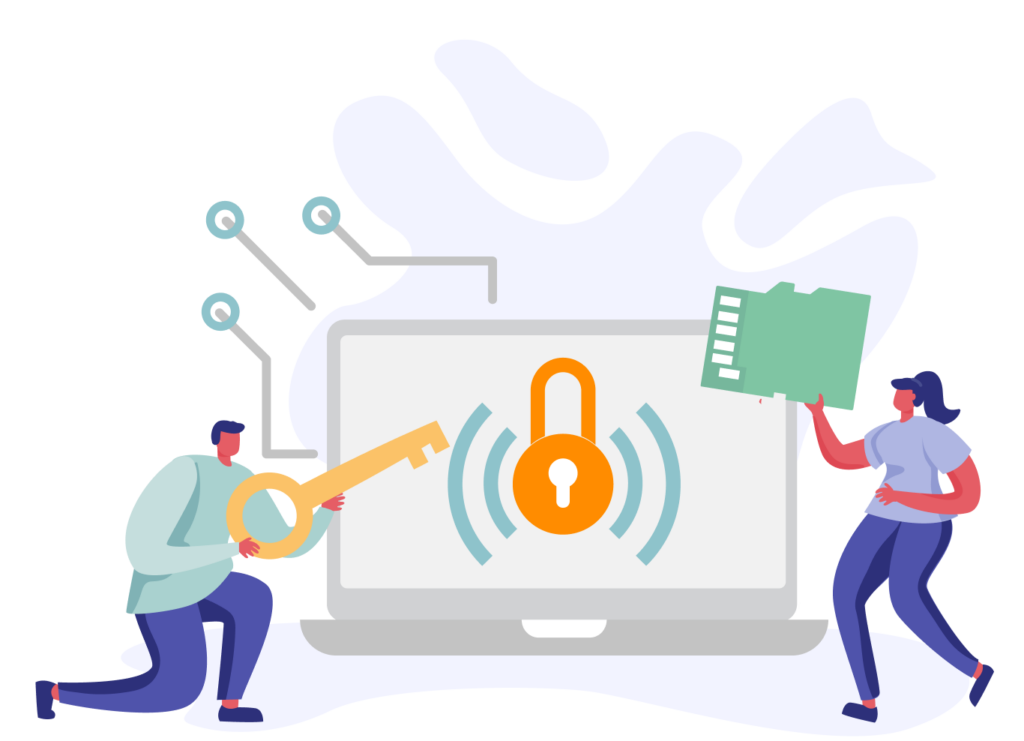Now more than ever, data protection should be top of mind for anyone working in the compliance space. There’s an increasing number of information security and privacy regulations and standards that companies must conform to in order to do business with their target customers. What’s more, these data protection compliance standards (e.g., SOC 2, CSA STAR, CMMC, ISO 27001, NIST 800-53) are getting updated more frequently than in the past.
It can be difficult and time-intensive to ensure that each separate standard is met. But, there are strategies you can implement that will help you work towards meeting all of the standards and regulations you’re liable for.
In this article, we dig into what data compliance is, the common cybersecurity and data protection/privacy regulations that need to be met, and how to ensure data compliance.
What is Data Compliance?

Data compliance, short-hand for data protection compliance, is the process of following various regulations and standards to maintain the integrity and availability of regulated data (e.g. personally identifiable information, medical information) and/or sensitive data (e.g. customer lists). All of this is done to help ensure the protection of regulated and/or sensitive data from unauthorized use. Another key piece of data compliance is tracking what kind of and how much data is being stored, and how that stored data is being managed through its lifecycle.
Data Protection Regulations and Standards
There’s a myriad of industry-specific and location-specific regulations revolving around data security and data privacy at this point. Below are some of the most well-known data protection regulations.
HIPAA
HIPAA, formally known as the Health Insurance Portability and Accountability Act of 1996, sets the data security standards for how businesses and providers must handle patients’ personal health information (PHI) to ensure it’s kept confidential and safe.
All “covered entities” as defined by HIPAA are required to maintain HIPAA compliance. Covered entities include not only providers and health plans, but also business associates that have access to PHI, such as:
- Data transmission providers
- Medical transcriptionists
- Software businesses
- Insurance companies
Essentially, any organization that does business in healthcare must adhere to HIPAA data security and compliance standards.
Related Link: HIPAA Compliance: Why It Matters and How to Obtain It
GDPR
The General Data Protection Regulation, or GDPR, was enacted by the EU to protect their citizens’ data and the right to know the data providers collect about them. It also lays out strict rules for reporting breaches as well as how to store and protect data.
Any business with customers in the European Union is subject to GDPR, and the GDPR is one of the harsher regulations in terms of punishment. It allows for a tiered approach based on the seriousness of the violation, with the maximum penalty being 4% of annual global turnover or €20 Million—whichever is greater.
PCI-DSS
Payment Card Industry Data Security Standards (PCI-DSS) are developed by the Payment Card Industry Security Standards Council, which is an independent regulatory body. Unlike other regulations, it isn’t imposed by a government entity; it’s a set of contractual commitments enforced by the PCI SSC.
Any business that accepts, stores, or transmits cardholder data is subject to PCI-DSS and needs to have protections in place to ensure they’re properly handling and storing that data.
Even if you use a third-party organization to handle credit card payments, you’re expected to be in compliance with PCI-DSS. For guidance on how to achieve PCI-DSS compliance, download our ebook “PCI DSS Compliance: Why It Matters and How to Obtain It”
SOX
The Sarbanes-Oxley
The Sarbanes-Oxley Act of 2002 (SOX) was enacted shortly after the Enron scandal to prevent similar instances of fraud. While SOX primarily deals with financial reporting, it is still an important compliance consideration, and IT organizations still need to be aware and ensure financial reporting is accurate and timely. Every public company in the United States must be SOX compliant.
Do you need to expand your data security and compliance program to meet growing security demands? Learn more about Hyperproof’s compliance program that can scale with your enterprise.
Related Link: Regulation Updates
HITRUST
HITRUST is a leading data protection standards development and certification organization. It has created the HITRUST CSF information risk and compliance management framework.
While it isn’t a legal regime, HITRUST CSF is useful risk management and compliance framework for organizations to consider because it incorporates and harmonizes the largest number of authoritative sources of any security and privacy framework.
In June 2020, HITRUST added:
- The CMMC framework (the new cybersecurity standard that all Defense contractors and suppliers need to meet
- Two community-specific standards
- Updated existing sources
By making these necessary additions, HITRUST ensures the framework remains relevant to the fast-changing regulatory and risk-management landscape.
The Cybersecurity Maturity Model Certification (CMMC)
The Department of Defense (DOD) believes that security is a foundational aspect of all purchase decisions, and should not be traded along with cost, schedule, or performance. In January 2020, the DOD released the first version of the new Cybersecurity Maturity Model Certification (CMMC) in order to assess and enhance the cybersecurity posture of the Defense Industrial Base (DIB).
The CMMC is intended to serve as a verification mechanism to ensure appropriate levels of cybersecurity practices and processes are in place to ensure basic cyber hygiene and protect controlled unclassified information (CUI) and Federal Contract Information (FCI) that resides on the Department’s industry partners’ networks.
The CMMC combines various cybersecurity standards and best practices and maps these controls and processes across several maturity levels that range from basic cyber hygiene to advanced. It builds upon existing regulation (DFARS 252.204-7012) that is based on trust by adding a verification component with respect to cybersecurity requirements.
All companies conducting business with the DOD, including subcontractors, must be certified.
To learn more about the data security and compliance regulations your organization may be subject to give to your locations and industry, check out our data protection regulations glossary.
While each set of security compliance standards has unique requirements on how organizations ought to protect information systems and personal data and report data breaches, there are some overall strategies you can implement that will set your security compliance program up to be as successful as possible.

How Do You Ensure Data Compliance?
1. Make sure your data protection measures are up to date
Data protection is at the heart of these regulations. So while you’re ensuring you have a robust security compliance process in place, make sure you also have modern data compliance strategies in place as well. These data compliance strategies are critical to lowering the chance that your business experiences a data breach.
If your company’s data management and protection measures are out of date, you’ll find it much more difficult to keep up with data security and compliance standards that are developed with today’s technologies in mind.
Oftentimes, traditional data storage solutions don’t allow for the same:
- Record keeping
- Quick recall
- Deletion of data after the required time
And traditional data storage solutions are not as reliable, which puts your data and your company at an even greater risk.
Forbes Communication Council recommends five data protection strategies that can help prepare you for today’s data compliance regulation challenges:
- Identify all data created and owned by your business, wherever it resides.
- Classify user-identifiable data, including user-generated data (from website or mobile app interactions) and data generated on behalf of the user (by third parties).
- Simplify your data center and distributed business environment with fast, easy access to stored data.
- Give your IT infrastructure the capability to provision and reallocate resources as needed in a dynamic, software-defined storage environment.
- Ensure replication occurs at a separate disaster recovery location so that you have access to a complete second copy of your data if the primary copy fails. You can replicate at the storage-array level, the appliance level or the host-server level.
Furthermore, it’s important to review your data protection measures on a regular basis to ensure that they align with industry data security and compliance standards.
As regulations, your organization, the technology you utilize, your employees, and your customers grow and change, you need to adjust your policies, procedures and other controls that secure and protect your information assets.
At this time, data protection regulations are in a state of flux, and you can expect the standards and frameworks that govern IT compliance (e.g. SOC 2) to change accordingly.
Compliance operations software such as Hyperproof can help you quickly stand up an information security compliance program and keep internal controls up-to-date.
2. Keep detailed records of data protection measures and audit procedures
It is essential to keep a record of all of your data protection measures and audit procedures for three reasons:
First, this record will ensure that the detailed knowledge of your company’s compliance activities doesn’t leave with a single employee. Without this record, your organization could be in the dark, and it increases the chances that an audit will uncover gaping holes in the data security and compliance program.
Second, this compliance activity record will serve as an example of your company’s good-faith efforts to comply with each set of regulations. Many regulations have built-in good-faith exceptions that allow regulators to soften punishment for companies with solid compliance programs in place or that are at least actively working to put one together.
Third, in order to pass an audit, you need to provide your auditor with evidence that you’re taking data security standards seriously. Auditors need detailed records in order to evaluate whether the controls you have in place would adequately protect the data you’re storing or processing. Working with auditors’ requirements in mind will help keep you focused on those critical items.
Hyperproof keeps your evidence items organized and tagged so that you can quickly locate and view that evidence. It also logs your compliance activities to easily show auditors what actions your organization has taken.
Related Link: Guidance on Conducting Audits
3. Have a point person for data security and compliance standards
With the previous points in mind, you might wonder, who is responsible for data compliance? Just like any other process, your data security and compliance process needs to have a single person in charge to manage all the moving pieces. This person should have a direct line to executives and have the credibility and authority to influence others throughout the company to meet data security and compliance standards.
This position is important for any company that is subject to any set of data security and compliance standards, but it’s required for some organizations under GDPR. A Data Protection Officer is an enterprise security leader required for companies handling certain amounts of data.
But, even if your company isn’t required to have a Data Protection Officer by GDPR, a data protection specialist will benefit most companies.
4. Use a Common Controls Framework
A Common Controls Framework (CCF) is a comprehensive set of control requirements, aggregated, correlated, and rationalized from the vast array of industry information security and privacy standards. Utilizing a CCF enables an organization to meet the requirements of this security, privacy, and other compliance programs while minimizing the risk of becoming “over-controlled”.
Implementing a common controls framework that is focused on the unique security of your organization is an effective way to reduce the operational disruption of your organization. Focusing on security first and mapping your security-focused controls to compliance frameworks will help you comply with several security certifications, standards, and regulations. Most frameworks have the same underlying security principles with minor differences in how you produce evidence and how your auditors evaluate your environment.
A common controls framework helps guide you and your auditors through existing compliance assessments. This central framework can also help you more easily identify any gaps with other frameworks that you may explore in the future. You can perform an analysis of your current control set against existing standards and avoid auditor fees for readiness assessments. This common framework helps you see your current state more accurately and allows you to easily adapt and expand into different security certifications and requirements.
Out of the box, Hyperproof provides a set of illustrative controls for many of the most commonly used security and privacy compliance frameworks, including NIST-CSF, PCI-DSS, ISO 27001, and many others. These controls are linked to program requirements providing a quick start approach for many organizations.

Why is Data Compliance Important?
When your organization takes data security and compliance seriously, you can expect to reap business benefits. For one, you will be able to assure customers that they can entrust you with their data. Getting a SOC 2 Type 2 report is a common way to address a customer’s concerns about the risks they take on when they choose to use your technology product.
Being able to pass IT audits (e.g. a SOC 2 assessment) has become table stakes if you want to sell products or services to enterprises today.
Further, taking security compliance standards seriously will help your organization minimize the risks of reputational and financial damage that result from experiencing data breaches.
Last but not least, when you take the time to establish and document processes around how your company handles sensitive information, ensures personal privacy, and responds to security incidents, it helps your organization stay resilient and nimble when your environment changes and the unexpected happens.
As your business grows, it’s important to question each aspect of your business and understand how proposed decisions (e.g. choosing to implement new third-party software, expanding into new geographies) may change your risk profile so you can develop data security systems and processes and policies to mitigate those risks as they emerge.
Why You Should Strive to Exceed Established Data Security and Compliance Standards
While it is important to do what you need to do to prove to auditors that your organization is meeting certain standards (e.g. SOC 2, HIPAA), you must keep in mind that maintaining a data protection compliance program is actually for your benefit. Taking a disciplined approach to compliance can help you significantly reduce the likelihood of events that compromise your customers’ data, your corporate IP, and your business operations. Taking a disciplined approach means that you assess your risks, the security of your environment, and the effectiveness of security and privacy policies, procedures, and protocols on an ongoing basis.
The data security and compliance strategies in this article can help you build a stronger, more reliable data protection program. Do you need to jumpstart your data security and compliance program? Find out how Hyperproof can customize a compliance solution for your enterprise.
Monthly Newsletter
Get the Latest on Compliance Operations.







